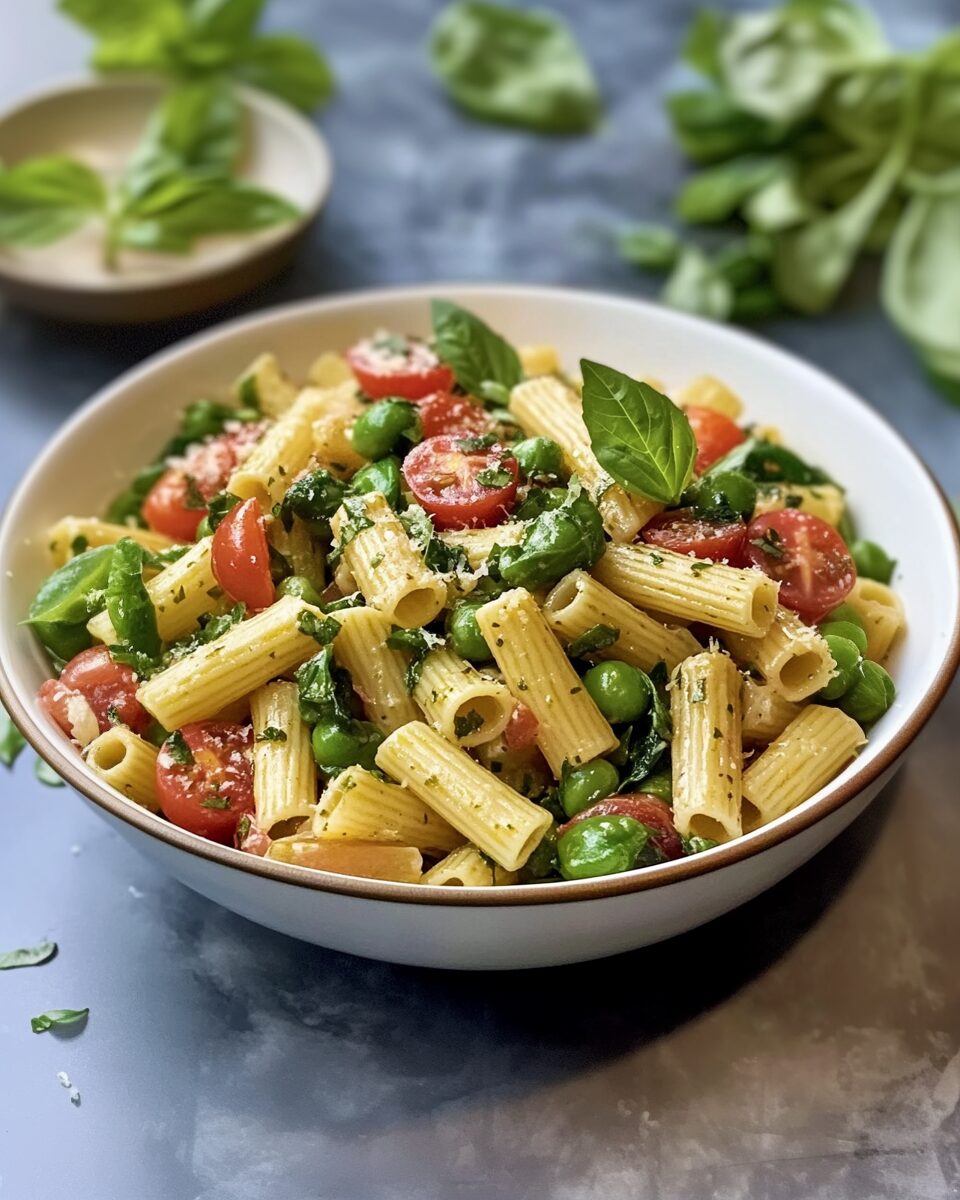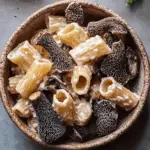Pasta Primavera is a vibrant, light dish that’s perfect for lighter evenings. It’s packed with fresh, seasonal vegetables that are tossed together with pasta and a simple sauce, making it burst with flavor and color. It’s incredibly versatile, and you can easily customize the vegetables to fit what you have on hand, making it a great way to use up any leftover bits and bobs in your fridge.
Full Recipe:
Ingredients
- Pasta (e.g., fusilli, penne)
- Asparagus
- Zucchini
- Cherry tomatoes
- Peas
- Red onion
- Garlic
- Lemon
- Olive oil
- Fresh basil
- Salt and pepper
Directions
- Cook the pasta according to package instructions. Reserve about ½ cup of the pasta water before draining.
- In a large pan, heat olive oil over medium heat. Sauté chopped red onion and minced garlic until translucent.
- Add chopped asparagus and zucchini to the pan. Cook until they begin to soften.
- Stir in cherry tomatoes and peas. Cook for a few more minutes until all vegetables are tender.
- Add the cooked pasta to the pan with the vegetables. Toss to combine.
- If the mixture seems dry, add some of the reserved pasta water to achieve the desired consistency.
- Season with salt, pepper, and a squeeze of fresh lemon juice.
- Garnish with fresh basil before serving.
Nutrients
Per serving (~418g):
- Calories: 521
- Total Fat: 23g (29% DV)
- Saturated Fat: 6.9g (34% DV)
- Cholesterol: 20mg (7% DV)
- Sodium: 546mg (24% DV)
- Total Carbohydrates: 62g (23% DV)
- Dietary Fiber: 8g (29% DV)
- Sugars: 7.9g
- Protein: 22g (44% DV)
- Calcium: 428mg (33% DV)
- Iron: 3.4mg (19% DV)
- Potassium: 806mg (17% DV)
The Origins of Pasta Primavera
Pasta Primavera’s history is quite interesting, as it was created in the early 1970s in New York City. The story goes that the dish was invented by Sirio Maccioni, an Italian restaurateur, at his popular restaurant, Le Cirque. According to the tale, Maccioni was inspired by the fresh produce he had available during a visit to a nearby farmers’ market. As the story unfolds, a famous food critic asked Maccioni for something light and healthy, and thus, Pasta Primavera was born. The dish quickly gained popularity due to its innovative concept of using fresh, seasonal vegetables to create a light yet flavorful pasta dish.
Over time, Pasta Primavera became a staple in American kitchens and was further popularized by its appearance in various cookbooks and on restaurant menus across the world. Despite its American origins, the dish has become synonymous with Italian cuisine, reflecting the spirit of fresh, seasonal cooking that is a hallmark of traditional Italian dishes.
Why Pasta Primavera Is Loved by Many
Pasta Primavera has earned its place as a beloved dish for several reasons. First and foremost, it is an incredibly easy and quick dish to prepare. With a relatively short cooking time and minimal ingredients, this dish can be whipped up in just under 30 minutes, making it an ideal weeknight dinner for busy individuals and families alike.
Another reason for its widespread appeal is its versatility. Pasta Primavera allows for countless variations depending on the vegetables available, and it can be customized to suit anyone’s preferences. From adding extra garlic and herbs for added flavor to switching up the pasta shape, the dish is as flexible as your imagination allows. It is also an excellent way to incorporate a wide variety of vegetables into your diet, especially those that are in season, which helps to ensure that you are getting the freshest produce available.
Furthermore, Pasta Primavera provides a perfect balance of flavors. The pasta acts as a neutral base that complements the fresh, slightly earthy taste of the vegetables, while the lemon and olive oil dressing bring a burst of freshness to the dish. When garnished with fresh basil or grated Parmesan cheese, it becomes an even more vibrant and flavorful meal that leaves diners satisfied.
Health Benefits of Pasta Primavera
Pasta Primavera is not just a delicious meal; it is also a healthy choice. The dish is loaded with vegetables that are packed with essential vitamins, minerals, and fiber. Vegetables such as zucchini, asparagus, peas, and cherry tomatoes are rich in antioxidants, which help to protect the body from damage caused by free radicals. These vegetables are also a good source of vitamins A, C, and K, which support healthy vision, immune function, and bone health.
The addition of olive oil not only enhances the flavor but also provides heart-healthy monounsaturated fats that have been shown to reduce the risk of heart disease. Olive oil is also rich in antioxidants, which further support the body’s overall health and well-being.
In terms of macronutrients, Pasta Primavera provides a well-rounded balance of carbohydrates from the pasta, healthy fats from the olive oil, and protein from the vegetables. This combination helps keep you full and satisfied while providing the necessary nutrients your body needs to function optimally.
For those following specific dietary plans, Pasta Primavera is highly adaptable. For example, it can easily be made gluten-free by using gluten-free pasta, or it can be made vegan by omitting cheese and using plant-based alternatives. This flexibility ensures that Pasta Primavera can be enjoyed by nearly everyone, regardless of dietary restrictions.
Pasta Primavera as a Versatile Dish for All Occasions
Pasta Primavera is a versatile dish that works for many occasions. It is equally at home as a weeknight dinner as it is at a weekend barbecue or a formal gathering. The colorful nature of the dish makes it visually appealing, adding a burst of color to any table. It is also perfect for those who want to serve a dish that is both healthy and indulgent at the same time.
In addition to being served as a main dish, Pasta Primavera can be a great side dish for a variety of proteins, including grilled chicken, fish, or even shrimp. The lightness of the vegetables and pasta complement richer proteins, creating a balanced and flavorful meal.
Pasta Primavera is also an excellent dish for meal prepping. The leftovers can easily be stored in the refrigerator for up to a few days, allowing you to enjoy the dish for lunch or dinner throughout the week. It is just as delicious when reheated, making it a convenient option for busy days when you don’t have time to cook.
Customizing Pasta Primavera
One of the best aspects of Pasta Primavera is how customizable it is. Depending on the season or your preferences, you can use different vegetables to suit the time of year or to take advantage of what’s available in your area. In the spring and summer, you might use vegetables such as zucchini, peas, bell peppers, and tomatoes, while in the fall and winter, you can swap in root vegetables like carrots, squash, or sweet potatoes.
You can also adjust the flavor profile of the dish to match your taste preferences. For example, if you like a bit of heat, you can add red pepper flakes or a pinch of cayenne pepper to give the dish a spicy kick. If you prefer a more earthy flavor, try incorporating mushrooms or even roasted garlic into the vegetable mix.
For a richer, more indulgent version of Pasta Primavera, you can add a creamy sauce or a generous sprinkle of Parmesan cheese. On the other hand, if you’re aiming for a lighter dish, you can keep the sauce simple with olive oil, lemon, and fresh herbs.
Conclusion
Pasta Primavera is an ideal dish for those who want a fresh, healthy, and customizable meal. Its simplicity, versatility, and vibrant flavors make it a favorite among home cooks and professional chefs alike. Whether you’re cooking for a family dinner, a special occasion, or meal prepping for the week, Pasta Primavera is sure to impress with its combination of fresh ingredients and satisfying flavors.






